Coupled Coordination and the Spatial Connection Network Analysis of New Urbanization and Ecological Resilience in the Urban Agglomeration of Central Guizhou, China
Abstract
1. Introduction
2. Materials and Methods
2.1. Study Area and Data Sources
2.1.1. Study Area
2.1.2. Data Sources
2.2. Methods
2.2.1. Construction of Evaluation Indicator System for NU
2.2.2. Three-Dimensional Model for Evaluating ER: Resistance–Adaptability–Recovery
- Resistance
- 2.
- Adaptability
- 3.
- Recovery
2.2.3. Modified CCD Model
2.2.4. Spatial Autocorrelation Analysis
- The global Moran’s I index
- The local Moran’s I index
2.2.5. Modified Gravity Model
2.2.6. Trend Surface Analysis
2.2.7. SNA
3. Results
3.1. Spatiotemporal Evolutionary Characteristics of NU and ER
3.1.1. Spatiotemporal Evolutionary Characteristics of NU
3.1.2. Spatiotemporal Evolutionary Characteristics of ER Level
3.2. Spatiotemporal Evolutionary and Spatial Clustering Characteristics of the CCD
3.2.1. Spatiotemporal Evolutionary Characteristics of the CCD
3.2.2. Spatial Clustering Characteristics of the CCD
3.2.3. Trend Surface Analysis of the CCD
3.3. SCN Characterization of the CCD
3.3.1. Integral Characterization of the SCN
3.3.2. Individual Characterization of the SCN
- Degree centrality analysis
- 2.
- Proximity centrality analysis
- 3.
- Intermediary centrality analysis
3.3.3. Core–Edge Analysis
4. Discussion
4.1. Spatiotemporal Evolutionary Characteristics of the CCD of NU and ER
4.2. Characteristics of the SCN of the CCD
4.3. Limitations and Future Research
5. Conclusions
- From 2010 to 2020, NU quality in the Urban Agglomeration of Central Guizhou gradually increases, but there is a downward trend in the ER level and a spatial overlap between their high-level and low-level zones.
- During the study period, the CCD of NU and ER in the Urban Agglomeration of Central Guizhou shows an overall decreasing trend and basic coupling dissonance. The overall pattern is west > north > south > east > central, showing a double U-shaped arc. Spatially, there is a positive correlation, dominated by the low-low agglomeration in the central region and high-high agglomeration in the southwestern region.
- During the study period, the SCN of the CCD of NU and ER showed active, dense, and complex characteristics, with no “island nodes” in the network. The network density increased from 0.7367 in 2010 to 0.7576 in 2015 and then decreased to 0.6477 in 2020. The network connection was 1, and network efficiency decreased from 0.2802 in 2010 to 0.2581 and then increased to 0.3750 in 2020.
- During the study period, the SCN of the CCD of NU and ER in the Urban Agglomeration of Central Guizhou has a significant core–edge characteristic. Nanming, Yunyan, Wudang, and other districts and counties have high degree centrality, proximity centrality, and intermediary centrality and have been in the core of the network for a long time. This indicates that the center of the SCN has strong control over regional elements.
Author Contributions
Funding
Data Availability Statement
Conflicts of Interest
References
- Yu, B. Ecological effects of new-type urbanization in China. Renew. Sust. Energy Rev. 2021, 135, 110239. [Google Scholar] [CrossRef]
- Wang, S.; Fang, C.; Guan, X.; Pang, B.; Ma, H. Urbanisation, energy consumption, and carbon dioxide emissions in China: A panel data analysis of China’s provinces. Appl. Energy 2014, 136, 738–749. [Google Scholar] [CrossRef]
- Chen, W.; Chi, G. Urbanization and ecosystem services: The multi-scale spatial spillover effects and spatial variations. Land Use Policy 2022, 114, 105964. [Google Scholar] [CrossRef]
- Deng, X.; Huang, J.; Rozelle, S.; Zhang, J.; Li, Z. Impact of urbanization on cultivated land changes in China. Land Use Policy 2015, 45, 1–7. [Google Scholar] [CrossRef]
- Bai, X.; McPhearson, T.; Cleugh, H.; Nagendra, H.; Tong, X.; Zhu, T.; Zhu, Y. Linking Urbanization and the Environment: Conceptual and Empirical Advances. Annu. Rev. Environ. Resour. 2016, 42, 215–240. [Google Scholar] [CrossRef]
- Reid, W.V.; Chen, D.; Goldfarb, L.; Hackmann, H.; Lee, Y.T.; Mokhele, K.; Ostrom, E.; Raivio, K.; Rockstrom, J.; Schellnhuber, H.J.; et al. Environment and development. Earth system science for global sustainability: Grand challenges. Science 2010, 330, 916–917. [Google Scholar] [CrossRef] [PubMed]
- Chang, Q.; Sha, Y.; Chen, Y. The Coupling Coordination and Influencing Factors of Urbanization and Ecological Resilience in the Yangtze River Delta Urban Agglomeration, China. Land 2024, 13, 111. [Google Scholar] [CrossRef]
- Scheffer, M.; Carpenter, S.R.; Dakos, V.; van Nes, E.H. Generic Indicators of Ecological Resilience: Inferring the Chance of a Critical Transition. Annu. Rev. Ecol. Evol. Syst. 2015, 46, 145–167. [Google Scholar] [CrossRef]
- Hoiling, C.S. Resilience and stability of ecological systems. Annu. Rev. Ecol. Evol. Syst. 1973, 4, 1–23. [Google Scholar] [CrossRef]
- Xiao, S.; Duo, L.; Guo, X.; Zou, Z.; Li, Y.; Zhao, D. Research on the coupling coordination and driving role of urbanization and ecological resilience in the middle and lower reaches of the Yangtze River. PeerJ 2023, 11, 15869. [Google Scholar] [CrossRef] [PubMed]
- Folke, C. Resilience. Ecol. Soc. 2016, 21, 44. [Google Scholar] [CrossRef]
- Bautista-Puig, N.; Benayas, J.; Mañana-Rodríguez, J.; Suárez, M.; Sanz-Casado, E. The role of urban resilience in research and its contribution to sustainability. Cities 2022, 126, 103715. [Google Scholar] [CrossRef]
- Wang, X.; Palazzo, D.; Carper, M. Ecological wisdom as an emerging field of scholarly inquiry in urban planning and design. Landsc. Urban Plan. 2016, 155, 100–107. [Google Scholar] [CrossRef]
- Ahern, J. Urban landscape sustainability and resilience: The promise and challenges of integrating ecology with urban planning and design. Landsc. Ecol. 2013, 28, 1203–1212. [Google Scholar] [CrossRef]
- Jin, L.; Kim, M.; Chon, J. Modeling the resilient supply of ecosystem function for climate change adaptive management in Wetland City. J. Environ. Manag. 2022, 322, 115788. [Google Scholar] [CrossRef]
- Voskamp, I.M.; Van de Ven, F.H.M. Planning support system for climate adaptation: Composing effective sets of blue-green measures to reduce urban vulnerability to extreme weather events. Build. Environ. 2015, 83, 159–167. [Google Scholar] [CrossRef]
- Huang, J.; Zhong, P.; Zhang, J.; Zhang, L. Spatial-temporal differentiation and driving factors of ecological resilience in the Yellow River Basin, China. Ecol. Indic. 2023, 154, 110763. [Google Scholar] [CrossRef]
- Feng, X.; Xiu, C.; Bai, L.; Zhong, Y.; Wei, Y. Comprehensive evaluation of urban resilience based on the perspective of landscape pattern: A case study of Shenyang city. Cities 2020, 104, 102722. [Google Scholar] [CrossRef]
- Zheng, J.; Hu, Y.; Boldanov, T.; Bazarzhapov, T.; Meng, D.; Li, Y.; Dong, S. Comprehensive assessment of the coupling coordination degree between urbanization and ecological environment in the Siberian and Far East Federal Districts, Russia from 2005 to 2017. PeerJ 2020, 8, e9125. [Google Scholar] [CrossRef] [PubMed]
- Ma, M.; Tang, J. Interactive coercive relationship and spatio-temporal coupling coordination degree between tourism urbanization and eco-environment: A case study in Western China. Ecol. Indic. 2022, 142, 109149. [Google Scholar] [CrossRef]
- Chen, M.; Liu, W.; Lu, D. Challenges and the way forward in China’s new-type urbanization. Land Use Policy 2016, 55, 334–339. [Google Scholar] [CrossRef]
- Chen, M.; Ye, C.; Lu, D.; Sui, Y.; Guo, S. Cognition and construction of the theoretical connotations of new urbanization with Chinese characteristics. J. Geogr. Sci. 2019, 29, 1681–1698. [Google Scholar] [CrossRef]
- Yang, Q.; Yang, D.; Li, P.; Liang, S.; Zhang, Z. Resilient City: A Bibliometric Analysis and Visualization. Discret. Dyn. Nat. Soc. 2021, 2021, 5558497. [Google Scholar] [CrossRef]
- Wu, C.; Cenci, J.; Wang, W.; Zhang, J. Resilient City: Characterization, Challenges and Outlooks. Buildings 2022, 12, 516. [Google Scholar] [CrossRef]
- Li, J.; Li, F.; Li, J. Does new-type urbanization help reduce haze pollution damage? Evidence from China’s county-level panel data. Environ. Sci. Pollut. Res. 2022, 29, 47123–47136. [Google Scholar] [CrossRef] [PubMed]
- Bai, Y.; Deng, X.; Jiang, S.; Zhang, Q.; Wang, Z. Exploring the relationship between urbanization and urban eco-efficiency: Evidence from prefecture-level cities in China. J. Clean. Prod. 2018, 195, 1487–1496. [Google Scholar] [CrossRef]
- Wang, S.; Cui, Z.; Lin, J.; Xie, J.; Su, K. The coupling relationship between urbanization and ecological resilience in the Pearl River Delta. J. Geogr. Sci. 2022, 32, 44–64. [Google Scholar] [CrossRef]
- Fan, X.; Hao, X.; Hao, H.; Zhang, J.; Li, Y. Comprehensive Assessment Indicator of Ecosystem Resilience in Central Asia. Water 2021, 13, 124. [Google Scholar] [CrossRef]
- Wang, S.; Li, Z.; Long, Y.; Yang, L.; Ding, X.; Sun, X.; Chen, T. Impacts of urbanization on the spatiotemporal evolution of ecological resilience in the Plateau Lake Area in Central Yunnan, China. Ecol. Indic. 2024, 160, 111836. [Google Scholar] [CrossRef]
- Ding, W.; Liu, J. Nonlinear and spatial spillover effects of urbanization on air pollution and ecological resilience in the Yellow River Basin. Environ. Sci. Pollut. Res. 2023, 30, 43229–43244. [Google Scholar] [CrossRef] [PubMed]
- Wang, L.; Yuan, M.; Li, H.; Chen, X. Exploring the coupling coordination of urban ecological resilience and new-type urbanization: The case of China’s Chengdu–Chongqing Economic Circle. Environ. Technol. Innov. 2023, 32, 103372. [Google Scholar] [CrossRef]
- Zhao, J.; Liu, Y.; Zhu, Y.; Qin, S.; Wang, Y.; Miao, C. Spatiotemporal differentiation and influencing factors of the coupling and coordinated development of new urbanization and ecological environment in the Yellow River Basin. Resour. Sci. 2020, 42, 159–171. [Google Scholar] [CrossRef]
- Zhang, L.; Gao, S.; Wei, B.; Li, Y.; Li, H.; Wang, L.; Ye, B. Effects of urbanization on rural drinking water quality in Beijing, China. Sustainability 2017, 9, 461. [Google Scholar] [CrossRef]
- Liao, Z.; Zhang, L. Spatio-temporal pattern evolution and dynamic simulation of urban ecological resilience in Guangdong Province, China. Heliyon 2024, 10, e25127. [Google Scholar] [CrossRef]
- Deng, Z.; Chen, Y.; Jiang, F.; Zhang, Y.; Xie, Z.; Zhao, Y.Z.L. Spatio-temporal study on coupling coordination between urbanization and eco-resilience in the Erhai Lake Basin. All Earth 2024, 1, 1–20. [Google Scholar] [CrossRef]
- Zou, C.; Zhu, J.; Lou, K.; Yang, L. Coupling coordination and spatiotemporal heterogeneity between urbanization and ecological environment in Shaanxi Province, China. Ecol. Indic. 2022, 141, 109152. [Google Scholar] [CrossRef]
- Chen, Z.; Sarkar, A.; Rahman, A.; Li, X.; Xia, X. Exploring the drivers of green agricultural development (GAD) in China: A spatial association network structure approaches. Land Use Policy 2022, 112, 105827. [Google Scholar] [CrossRef]
- Bai, C.; Zhou, L.; Xia, M.; Feng, C. Analysis of the spatial association network structure of China’s transportation carbon emissions and its driving factors. J. Environ. Manag. 2020, 253, 109765. [Google Scholar] [CrossRef] [PubMed]
- Feng, X.; Lei, J.; Xiu, C.; Li, J.; Bai, L.; Zhong, Y. Analysis of Spatial Scale Effect on Urban Resilience: A Case Study of Shenyang, China. Chin. Geogr. Sci. 2020, 30, 1005–1021. [Google Scholar] [CrossRef]
- Jiao, Z.; Wua, Z.; Wei, B.; Luo, Y.; Lin, Y.; Xue, Y.; Li, S.; Gao, F. Introducing big data to measure the spatial heterogeneity of human activities for optimizing the ecological security pattern: A case study from Guangzhou City, China. Ecol. Indic. 2023, 150, 110203. [Google Scholar] [CrossRef]
- Fang, C.; Yu, D. Urban agglomeration: An evolving concept of an emerging phenomenon. Landsc. Urban Plan. 2017, 162, 126–136. [Google Scholar] [CrossRef]
- Zeng, C.; Wu, S.; Zhou, H.; Cheng, M. The impact of urbanization growth patterns on carbon dioxide emissions: Evidence from Guizhou, West of China. Land 2022, 11, 1211. [Google Scholar] [CrossRef]
- Lu, Q.; Zhao, C.; Huang, H. Comparative study on the temporal and spatial evolution of the ecosystem service value of different Karst Landform types: A case study in Guizhou Province, China. Appl. Sci. 2022, 12, 12801. [Google Scholar] [CrossRef]
- Yuan, Q.; Li, R. The negative impacts of human activities on the ecological corridor in the karst highly urbanized area are gradually diminishing: A case study from the karst mountain cities in Southwest China. Ecol. Indic. 2023, 157, 111257. [Google Scholar] [CrossRef]
- Xu, H.; Zhang, W. The causal relationship between carbon emissions and land urbanization quality: A panel data analysis for Chinese provinces. J. Clean. Prod. 2016, 137, 241–248. [Google Scholar] [CrossRef]
- Shang, J.; Wang, Z.; Li, L.; Chen, Y.; Li, P. A study on the correlation between technology innovation and the new-type urbanization in Shaanxi province. Technol. Forecast. Soc. 2018, 135, 266–273. [Google Scholar] [CrossRef]
- Zhang, W.; Wang, M.Y. Spatial-temporal characteristics and determinants of land urbanization quality in China: Evidence from 285 prefecture-level cities. Sustain. Cities Soc. 2018, 38, 70–79. [Google Scholar] [CrossRef]
- Zhou, G.; Gu, Y.; Yuan, H.; Gong, Y.; Wu, Y. Selecting sustainable technologies for disposal of municipal sewage sludge using a multi-criterion decision-making method: A case study from China. Resour. Conserv. Recycl. 2020, 161, 104881. [Google Scholar] [CrossRef]
- Gupta, H.V.; Kling, H.; Yilmaz, K.K.; Martinez, G.F. Decomposition of the mean squared error and NSE performance criteria: Implications for improving hydrological modelling. J. Hydrol. 2009, 377, 80–91. [Google Scholar] [CrossRef]
- Su-ling, H.; Feng-qiong, Z.; Jin-liang, W. Ecological sensitivity evaluation of Longnan County based on AHP and MSE weighting method. Chin. J. Ecol. 2021, 40, 2927–2935. [Google Scholar]
- Feng, Z.; Hongwei, Z. “AHP+entropy weight method” based CW-TOPSIS model for predicting rock burst. China Saf. Sci. 2017, 27, 128–133. [Google Scholar]
- Chen, C.; Xu, L.; Zhao, D.; Xu, T.; Lei, P. A new model for describing the urban resilience considering adaptability, resistance and recovery. Saf. Sci. 2020, 128, 104756. [Google Scholar] [CrossRef]
- Chuyu, X.; Zhaoyingzi, D.; Bin, C. Spatio-temporal analysis and simulation of urban ecological resilience: A case study of Hangzhou. Acta Ecol. Sin. 2022, 42, 116–126. [Google Scholar]
- Gao, X.; Shen, J.; He, W.; Zhao, X.; Li, Z.; Hu, W.; Wang, J.; Ren, Y.; Zhang, X. Spatial-temporal analysis of ecosystem services value and research on ecological compensation in Taihu Lake Basin of Jiangsu Province in China from 2005 to 2018. J. Clean. Prod. 2021, 317, 128241. [Google Scholar] [CrossRef]
- Guilin, L.; Luocheng, Z.; Qian, Z. Spatial and temporal dynamics of land use and its influence on ecosystem service value in Yangtze River Delta. Acta Ecol. Sin. 2014, 34, 3311–3319. [Google Scholar]
- Peng, J.; Liu, Y.; Wu, J.; Lv, H.; Hu, X. Linking ecosystem services and landscape patterns to assess urban ecosystem health: A case study in Shenzhen City, China. Landsc. Urban Plan. 2015, 143, 56–68. [Google Scholar] [CrossRef]
- Shu-Jia, W.; Wei, K.; Liang, R.; Dan-dan, Z.; Bin-ting, D. Research on misuses and modification of coupling coordination degree model in China. J. Nat. Resour. 2021, 36, 793–810. [Google Scholar]
- Xiaoxiao, X.; Xiaoli, Z.; Weichen, G.; Qiqi, Z. Research on the spatiotemporal evolution of modern marine cities based on the entropy weight TOPSIS method-obstacle degree model-modified coupling coordination degree model. Bull. Mar. Sci. 2024, 1–17. [Google Scholar]
- He, J.; Wang, S.; Liu, Y.; Ma, H.; Liu, Q. Examining the relationship between urbanization and the eco-environment using a coupling analysis: A case study of Shanghai, China. Ecol. Indic. 2017, 77, 185–193. [Google Scholar] [CrossRef]
- Lv, K.; Feng, X.; Kelly, S.; Zhu, L.; Deng, M. A study on embodied carbon transfer at the provincial level of China from a social network perspective. J. Clean. Prod. 2019, 225, 1089–1104. [Google Scholar] [CrossRef]
- Du, Y.; Wan, Q.; Liu, H.; Liu, H.; Kapsar, K.; Peng, J. How does urbanization influence PM2.5 concentrations? Perspective of spillover effect of multi-dimensional urbanization impact. J. Clean. Prod. 2019, 220, 974–983. [Google Scholar] [CrossRef]
- Gurney, K.R.; Romero-Lankao, P.; Seto, K.C.; Hutyra, L.R.; Duren, R.; Kennedy, C.; Grimm, N.B.; Ehleringer, J.R.; Marcotullio, P.; Hughes, S.; et al. Climate change: Track urban emissions on a human scale. Nature 2015, 525, 179–181. [Google Scholar] [CrossRef]
- Hu, C.; Wu, W.; Zhou, X.; Wang, Z. Spatiotemporal changes in landscape patterns in karst mountainous regions based on the optimal landscape scale: A case study of Guiyang City in Guizhou Province, China. Ecol. Indic. 2023, 150, 110211. [Google Scholar] [CrossRef]
- Liu, Y.; Huang, X.; Yang, H.; Zhong, T. Environmental effects of land-use/cover change caused by urbanization and policies in Southwest China Karst area: A case study of Guiyang. Habitat Int. 2014, 44, 339–348. [Google Scholar] [CrossRef]
- Liu, S.; Wang, Z.; Wu, W.; Yu, L. Effects of landscape pattern change on ecosystem services and its interactions in karst cities: A case study of Guiyang City in China. Ecol. Indic. 2022, 145, 109646. [Google Scholar] [CrossRef]
- Xue, X.; Wang, Z.; Hou, S. NDVI-Based vegetation dynamics and response to climate changes and human activities in Guizhou Province, China. Forests 2023, 14, 753. [Google Scholar] [CrossRef]
- Yuan, L.; Liu, W.; Su, S.; Chen, Z. The rocky desertification management in Guizhou province under the localized governance system. Front. Environ. Sci. 2022, 10, 1065663. [Google Scholar] [CrossRef]


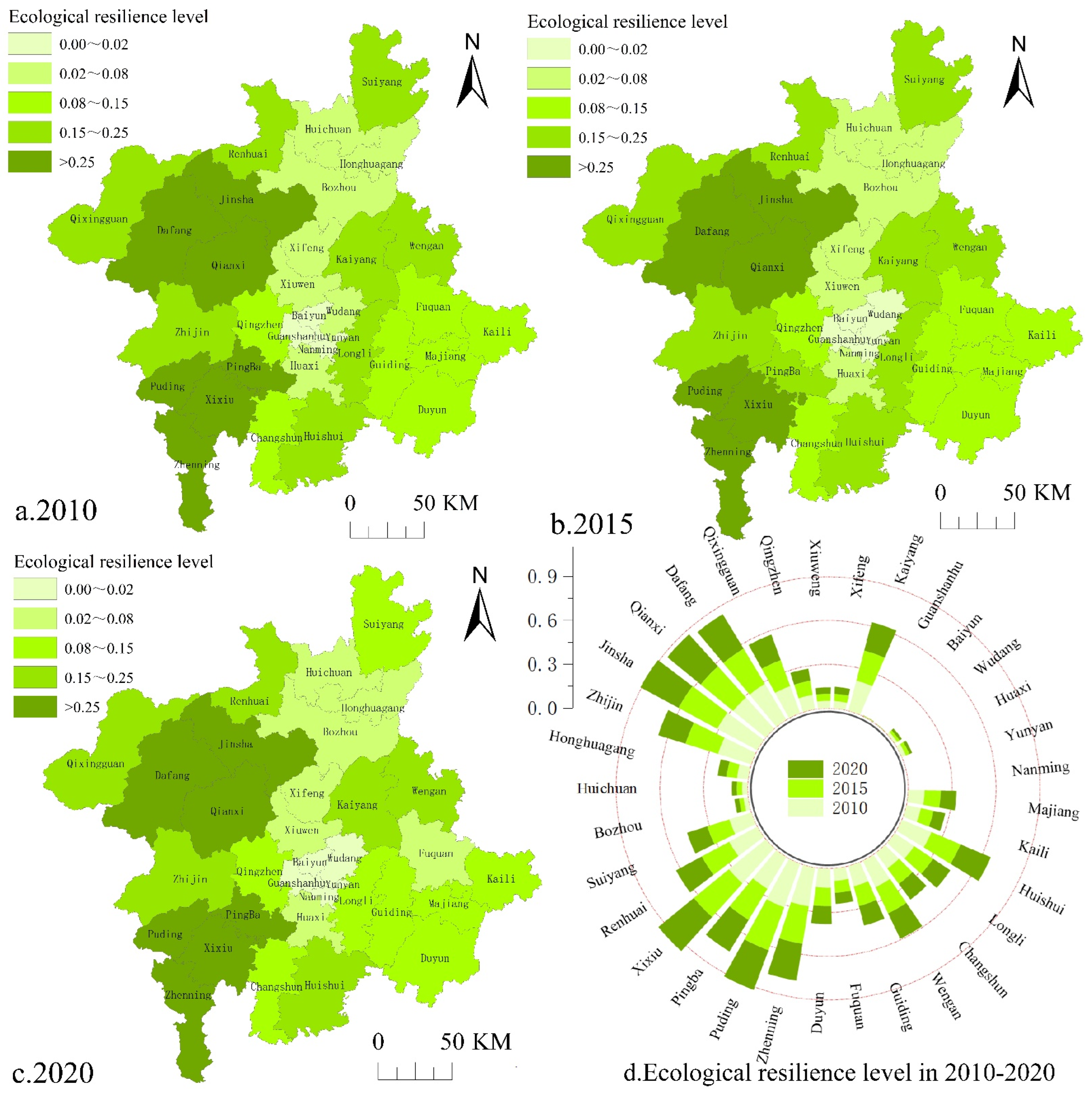
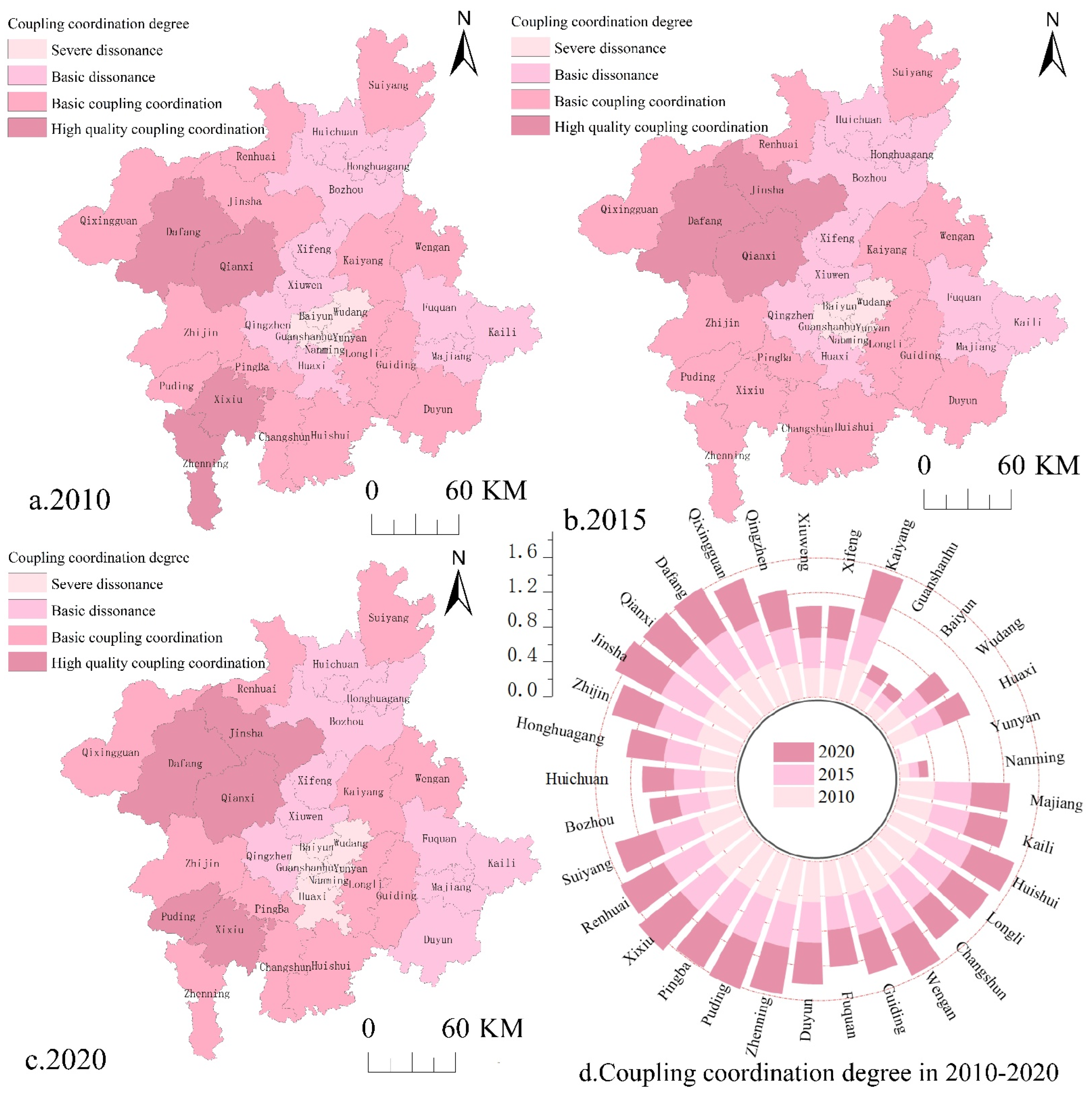
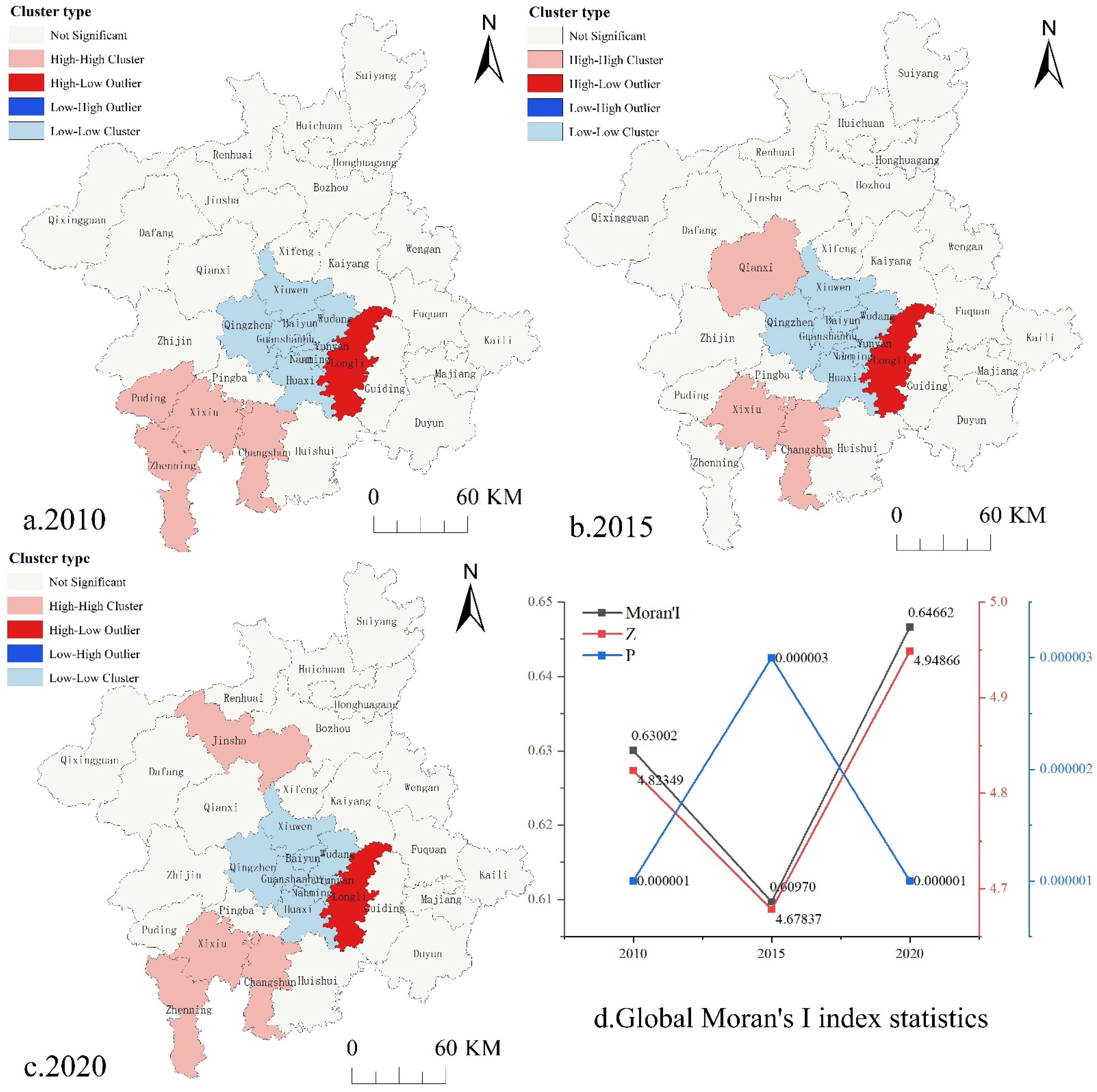
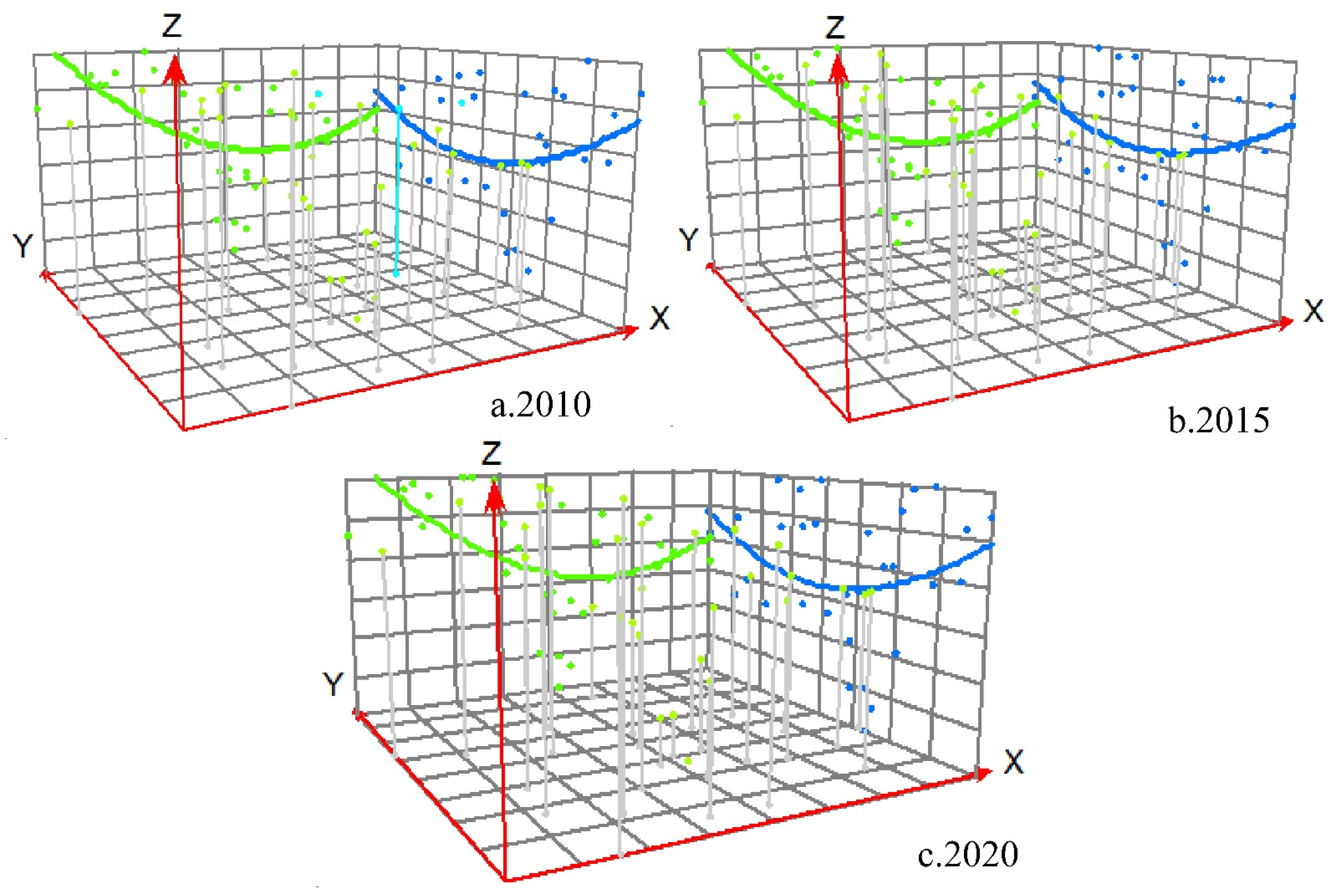

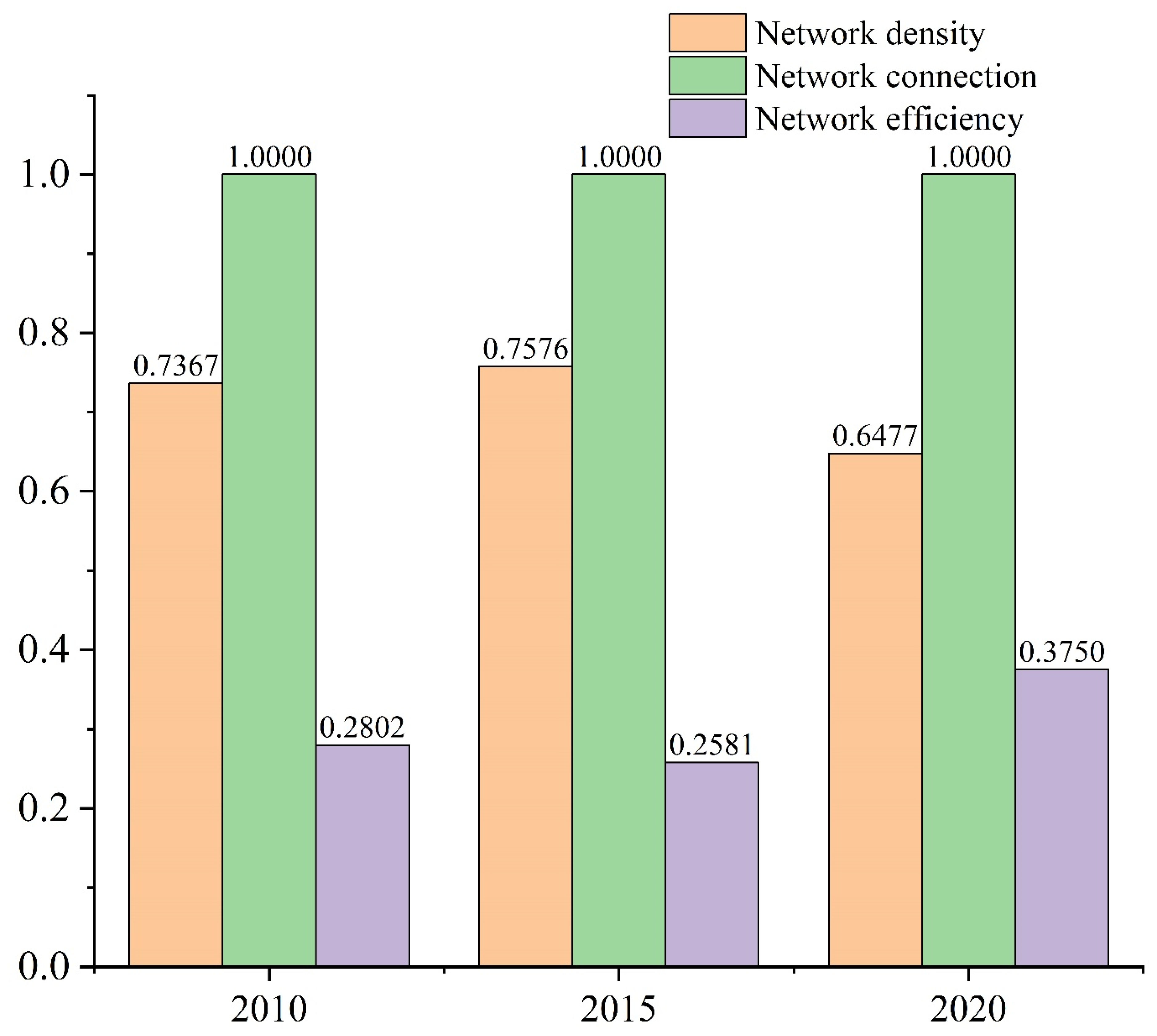


| Guideline Layer | Indicator Layer/Unit | Type | AHP Weights | MSE Weights | Combination Weights |
|---|---|---|---|---|---|
| Urbanization of population | Urbanization rate (%) | + | 0.0997 | 0.0980 | 0.0990 |
| Urban population density (person/km2) | + | 0.0997 | 0.0708 | 0.0876 | |
| Number of rural employees (million) | − | 0.0332 | 0.0934 | 0.0585 | |
| Spatial urbanization | Population density (persons/km2) | + | 0.0365 | 0.0658 | 0.0488 |
| Building land area (km2) | + | 0.1458 | 0.0803 | 0.1183 | |
| Urbanization of society | Disposable income per urban resident (CNY) | + | 0.1064 | 0.0907 | 0.0998 |
| Number of students enrolled in general secondary schools (persons) | + | 0.0266 | 0.0654 | 0.0429 | |
| Full-time teachers in general secondary schools (persons) | + | 0.0266 | 0.0586 | 0.0400 | |
| Ecological urbanization | Forest cover (%) | + | 0.0663 | 0.0896 | 0.0761 |
| PM2.5(ug/m3) | − | 0.0332 | 0.0894 | 0.0568 | |
| Economic urbanization | GDP per capita (CNY) | + | 0.0466 | 0.0527 | 0.0492 |
| Gross regional product (million dollars) | + | 0.1397 | 0.0608 | 0.1066 | |
| Percentage of output value of secondary and tertiary industries (%) | + | 0.1397 | 0.0844 | 0.1165 |
| Typology | Landscape Pattern Index | Weights |
|---|---|---|
| Landscape heterogeneity | Shannon’s diversity index (SHDI) | 0.2 |
| Area-weighted mean patch fractal dimension (AWMPFD) | 0.1 | |
| Landscape contagion index (CONTAG) | 0.2 | |
| Landscape connectivity | Patch cohesion (COHESION) | 0.25 |
| Landscape fragility (LFI) | 0.25 |
| Network Density Matrix | 2010 | 2015 | 2020 | |||
|---|---|---|---|---|---|---|
| Edge | Edge | Core | Edge | Core | Edge | |
| Edge | 0.801 | 0.822 | 0.95 | 0.758 | 0.731 | 0.652 |
| Edge | 0.822 | 0.091 | 0.758 | 0.288 | 0.652 | 0.156 |
Disclaimer/Publisher’s Note: The statements, opinions and data contained in all publications are solely those of the individual author(s) and contributor(s) and not of MDPI and/or the editor(s). MDPI and/or the editor(s) disclaim responsibility for any injury to people or property resulting from any ideas, methods, instructions or products referred to in the content. |
© 2024 by the authors. Licensee MDPI, Basel, Switzerland. This article is an open access article distributed under the terms and conditions of the Creative Commons Attribution (CC BY) license (https://creativecommons.org/licenses/by/4.0/).
Share and Cite
Wu, C.; Ren, H. Coupled Coordination and the Spatial Connection Network Analysis of New Urbanization and Ecological Resilience in the Urban Agglomeration of Central Guizhou, China. Land 2024, 13, 1256. https://doi.org/10.3390/land13081256
Wu C, Ren H. Coupled Coordination and the Spatial Connection Network Analysis of New Urbanization and Ecological Resilience in the Urban Agglomeration of Central Guizhou, China. Land. 2024; 13(8):1256. https://doi.org/10.3390/land13081256
Chicago/Turabian StyleWu, Chengmin, and Haili Ren. 2024. "Coupled Coordination and the Spatial Connection Network Analysis of New Urbanization and Ecological Resilience in the Urban Agglomeration of Central Guizhou, China" Land 13, no. 8: 1256. https://doi.org/10.3390/land13081256
APA StyleWu, C., & Ren, H. (2024). Coupled Coordination and the Spatial Connection Network Analysis of New Urbanization and Ecological Resilience in the Urban Agglomeration of Central Guizhou, China. Land, 13(8), 1256. https://doi.org/10.3390/land13081256






